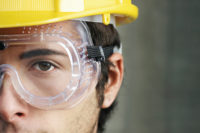Creating awareness
To combat these staggering statistics, effective safety training is needed to create an awareness about and respect for common fall hazards, convey the correct use and selection of fall protection equipment and teach workers best safety practices to avoid fall hazards altogether. A comprehensive fall protection program not only saves lives and reduces injuries, but also saves money and makes good business sense.
The technology exists to fully provide workers with proper and adequate fall protection. The individual worker has complete control in preventing workplace falls through the correct use of fall protection equipment and devices. However, only proper and effective safety training will ensure that workers will have the skills and motivation necessary to use this equipment correctly, and take all the needed measures to maintain their safety. Let's briefly examine some of these core components of effective training.
1) Hazard recognition
Workplace safety begins with the recognition of the potential risks involved, and by making sure that workers take action to either eliminate them or guard against them. The first component of any fall protection program is to increase workers' awareness of potential fall hazards that exist in their work environment.
Falls can be caused by various factors, but most are due to either environmental factors and personal factors. Environmental factors relate to the physical working conditions, including exposed high places with unprotected perimeters, or elevated areas without guardrails or other barriers. Personal factors include failing to properly select and use the correct fall protection equipment or disregarding engineering controls.
2) Fall prevention systems
Once potential fall hazards have been identified, the second step in a fall protection strategy is to implement measures to eliminate or control them. This is done through effective planning and the use of engineering controls, such as guardrails, scaffolding systems and platform barriers. These devices offer protection from falls and can safely elevate the work surface to the desired height.Events surrounding many types of fall incidents typically involve a number of factors, including unstable working surfaces and other environmental factors. Studies have shown that the use of guardrails, fall arrest systems, safety nets, covers and travel restriction systems can prevent many deaths and injuries from falls.
If exposure to fall hazards cannot be safely eliminated or controlled, or when engineering controls are not feasible, then the next component of a fall protection strategy becomes training workers to properly select and use protective equipment, such as fall arrest systems.
3) Fall arrest systems
Designed to stop a person in a fall when used properly, a personal fall arrest system can come in various possible configurations depending on the specific job task and working environment. In most cases, a basic fall arrest system consists of an anchorage, connectors, full-body harness and lanyard, along with such other components as a deceleration device or a lifeline.
4) Maintenance and care
Using the correct fall protection device for the work situation is crucial to providing employees with continuous protection from falls. But the condition of this equipment is equally important. Check the equipment for chemicals, dirt, moisture, oil and grease, as these elements can potentially adversely affect a fall arrest system. Job activities such as welding, sandblasting and chemical cleaning might also damage unprotected fall arrest components. Potential hazards like nearby electrical lines, extreme temperatures, moving machinery and other obstacles could also damage or degrade the equipment. Parts of the fall arrest system may also need to be protected from sharp or abrasive edges and surfaces while being used.When needed, fall protection devices can be washed in warm water using a mild detergent, rinsed thoroughly in clean warm water, and allowed to dry at room temperature. When they are dry, these items should be stored in a clean, dry area away from strong sunlight, extreme temperatures and hazardous substances that could degrade the materials.
Make sure your fall protection equipment is inspected by a competent, trained person before each use. Remove defective components from service immediately and tag or mark them as unusable. If repairs cannot be made by a qualified technician, the devices should be destroyed. Never use any equipment that does not pass inspection.
Leave no doubt
The crucial role of accurate safety training in protecting workers from the risk of injury or death due to falls cannot be overstated. Thorough fall protection training should include the following:
- Follow all established safe work procedures.
- Use the proper fall protection equipment for the job.
- Keep equipment maintained in good working order.
- Never use worn or defective equipment.
- When a personal fall arrest system is required, wear it at all times.
- Always inspect the fall arrest equipment before each and every use.
It is important not to forget to inspect engineering controls frequently, as well. Scaffolding and guardrails must also be inspected for damage that could affect their efficiency. Finally, if you have any doubts about the safety of your fall protection equipment, do not use it.
SIDEBAR: Lanyard do's & don'ts
